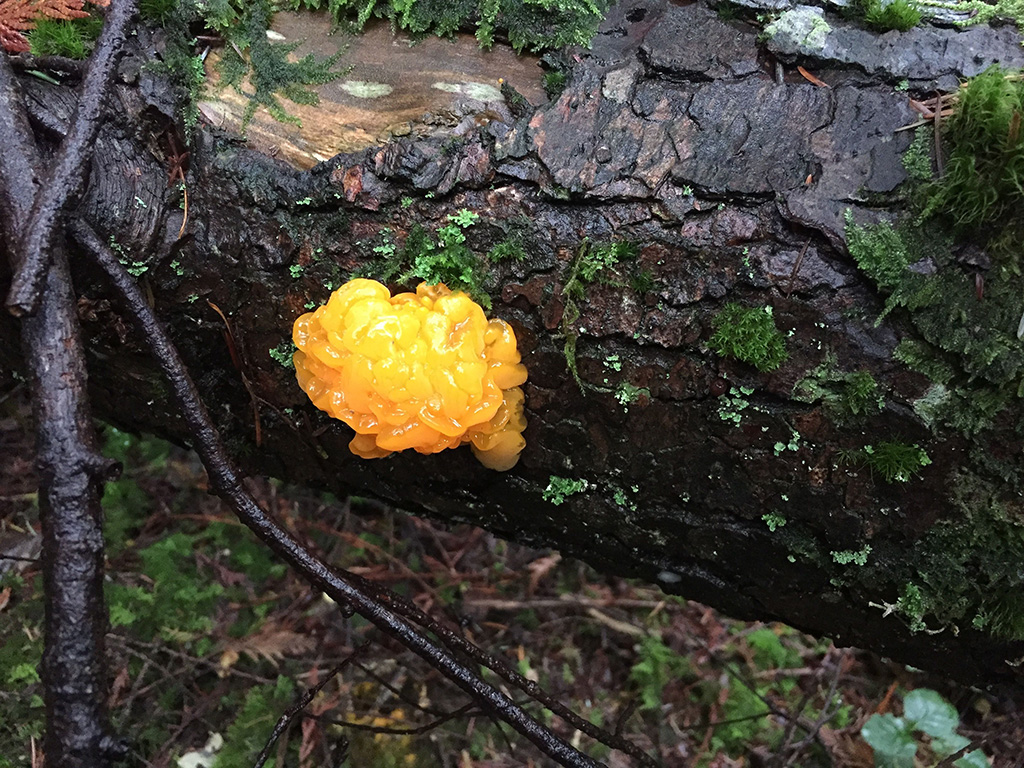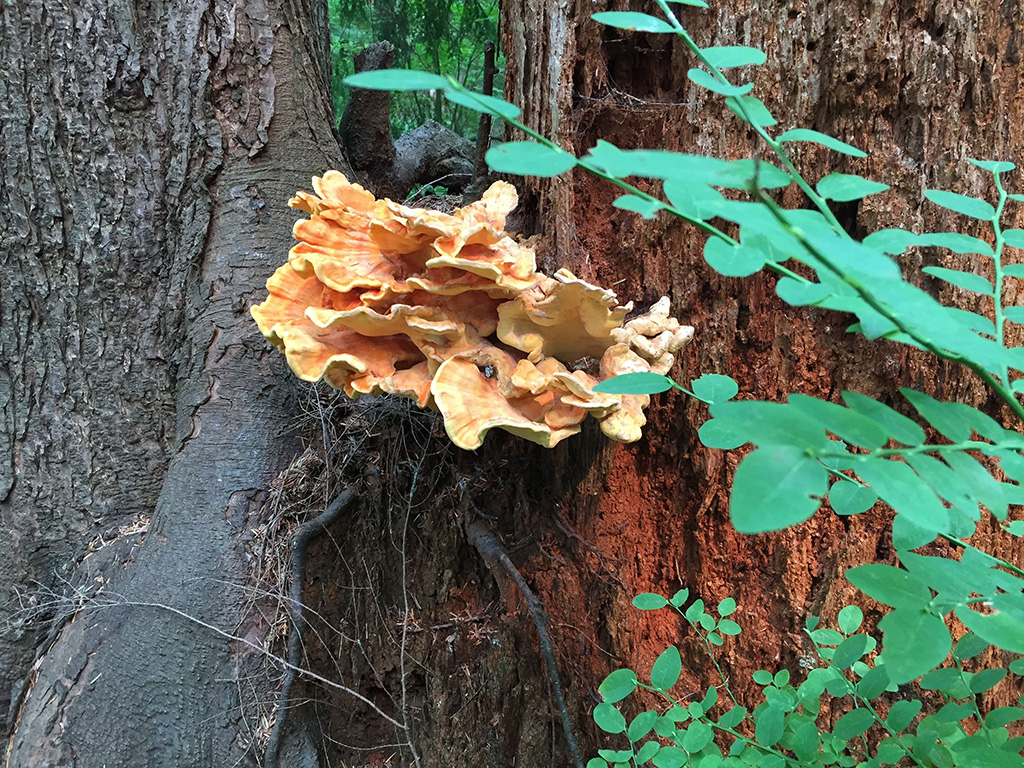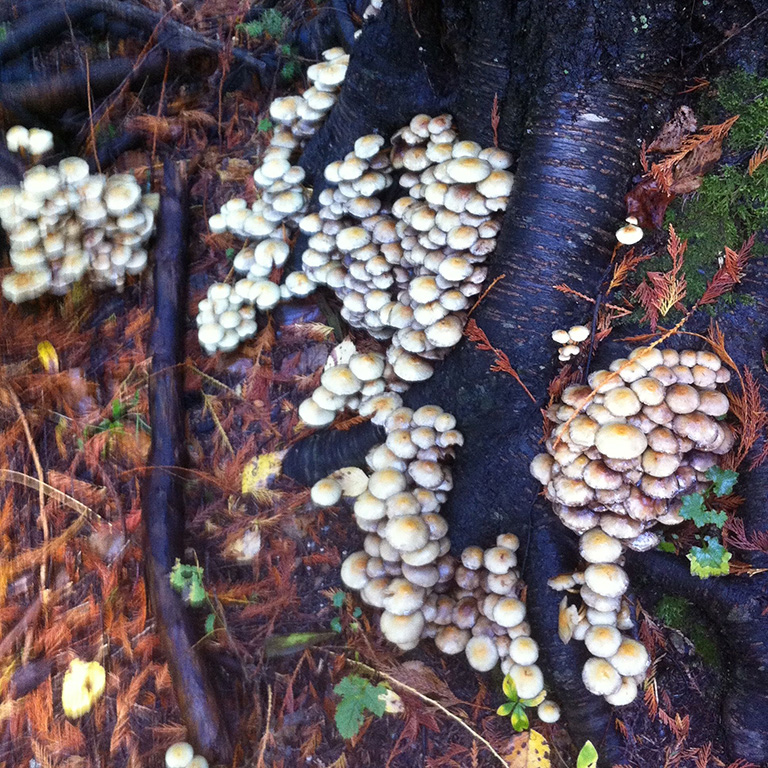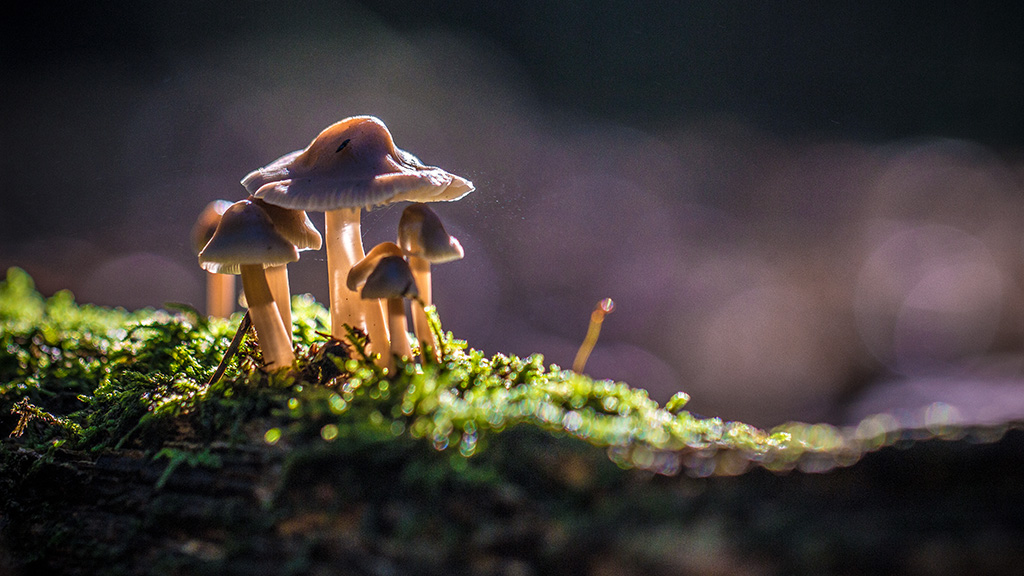Mycelium Running: How Mushrooms Can Help Save the World
By Paul Stamets
Ten Speed Press (2005)
Entangled Life: How Fungi Make Our Worlds, Change Our Minds & Shape Our Futures
By Merlin Sheldrake
Random House (2021)
Finding the Mother Tree: Discovering the Wisdom of the Forest
By Suzanne Simard
Allen Lane (2021)
“Language of fungi derived from their electrical spiking activity.”
By Andrew Adamatzky
Royal Society Open Science (April 2022)
For many years I’ve walked my dogs in our local park, a patch of second-growth timber that must have been clear cut a century ago. It’s a pleasant place, deliberately undeveloped except for a few boardwalks where the trails get muddy. I’ve enjoyed looking at the trees, ferns, huckleberries and salal, but it wasn’t until about 20 years ago that I actually saw a fungus there.
It was at the core of a split log, and nothing like a mushroom; it was white, almost translucent, and looked like ice. I realized it must be a fungus, and wondered what kind it might be. Perhaps a white coral, but I never saw it again.
But I began to see other fungi everywhere in the park: a couple of rotted stumps produce sulphur shelf fungi, and another stump is being patiently demolished by Hypholoma fasciculare, better known as wood-lovers or sulphur tufts. Orange jellies decorate countless fallen branches, and a patch of grass on the edge of the park sometimes erupts with the distinctive red caps of Amanita muscaria.
As a belated mycologist I’m terrible, but at least I realized that the fungi I was now staring at were just the fruiting bodies of the real organisms — a network of microscopic strands called hyphae that wound themselves into thicker strands called mycelium.

So I read a book called Mycelium Running. Paul Stamets is a mycelium scholar and advocate. Put your foot on the ground, Stamets told me, and you’re covering about 300 miles of mycelium. Mycelium is everywhere and, according to Stamets, can do almost anything from dismantling trees to cleaning up heavy-metal pollution and turning used diapers into tasty oyster mushrooms.
But he practically lost me in the first chapter, titled “Mycelium as Nature’s Internet,” which begins: “I believe that mycelium is the neurological network of nature. Interlacing mosaics of mycelium infuse habitats with information-sharing membranes.”
He only made matters worse when he claimed: “I believe that the mycelium operates at a level of complexity that exceeds the computational powers of our most advanced supercomputers. I see the mycelium as the Earth’s natural internet, a consciousness with which we might be able to communicate.”
Stamets’s book came out a decade after Suzanne Simard’s epochal experiments showing mycelium could transfer food from one tree to others, even trees of different species. So Stamets was aware of the “wood-wide web,” as Nature magazine called it, and he properly credits her.
But a supercomputer? That was going a little too far for me. I could admire Stamets’s love of mycelium and his inventiveness in using it for environmental and psychedelic cleanups. But I didn’t like the idea of something in the ground that felt my footsteps and might even have me in its database: There’s that old jerk again, with a new dog.
Still, as I walked in our local woods I took increasing note of the fungi, and began to realize they were indeed recycling the trees. We often have a blowdown, or a tree is cut down for safety reasons. Soon thereafter, fungi emerge, and I realize the mycelium has been quick to enter and consume the wood. A fallen log often sprouts polypores, “bracket fungi” that form semicircular shelves. They always align themselves with one side facing the sky and the other facing the ground. And so do polypores in dead trees that still stand.
Knowing which end is up
The mycelium in the tree is aware of gravity and aligns its polypores so the spores will be released toward the ground. Maybe there was some purely chemical or physical process at work, but it did make the mycelium look... kind of sentient. It’s aware of which end is up.
Stamets continued to put me off, however. Having made his assertions about fungal networks as supercomputers, he veered off into growing mushrooms for fun and profit and the environment, when he should have been developing code to communicate with mycelium.
I did accept the idea that this is the mycelium’s world. We’re just new tenants, and our talent for lease-breaking behaviour doesn’t suggest we’ll be here long, no matter how optimistic Stamets might be.
I approached another fungus book, Entangled Life, with cautious interest. Its author, Merlin Sheldrake, again offered amazing facts. He argues that fungi enabled primitive aquatic plants to colonize the land even before they had roots or stems or leaves. The fungi provided minerals and water that the plants needed; the plants provided sugars to feed the fungi. “Mycorrhizal” means fungus and root; all life on land has depended on this relationship for hundreds of millions of years.
“Today,” Sheldrake writes, “more than 90 per cent of all plant species depend on mycorrhizal fungi.” That’s not all: “Mycorrhizal fungi are so prolific that their mycelium makes up between a third and a half of the living mass of soils. Globally, the total length of mycorrhizal hyphae in the top 10 centimetres of soil is around half the width of our galaxy (4.5 times 1,017 kilometres of hyphae, versus 9.5 times 1,017 kilometres of space).”
Sheldrake offers another big number: “Today, fungal decomposition — much of it of woody plant matter — is one of the largest sources of carbon emission, emitting about 85 gigatonnes of carbon to the atmosphere every year. In 2018, the combustion of fossil fuels by humans emitted around 10 gigatonnes.” For some reason, though, fungi failed to break down early forests, which eventually became coal. So we owe our industrial world to this ancient fungal lapse.

Another doper’s memoir?
But I felt I was again venturing into fringe science. Sheldrake seemed entirely too interested in LSD and psilocybin, both fungus-derived drugs. I dropped the book as just another doper’s memoir. But some of what he said stuck with me, and when I returned to the book I wasn’t as put off by the psychedelic passages.
I was also a little more ready to accept Sheldrake’s argument that intelligence doesn’t need a human brain, or any brain at all: “Many types of brainless organisms — plants, fungi and slime molds included — respond to their environments in flexible ways, solve problems, and make decisions between alternative courses of action.” A single human neuron isn’t aware of itself, nor is a single termite. But a colony of termites can combine the neurons of its members in a kind of network and use them to build a termite mound.
“Brains,” says Sheldrake, “are just one such network, one way of processing information.” And perhaps far from the oldest. Fossilized mycelium has been found in rocks 2.4 billion years old.
One passage in particular made me think. He describes “zombie fungi” that infect insects and change the way they behave. Ophiocordyceps unilateralis infects carpenter ants and in effect makes them part of its reproductive cycle. Sheldrake explains:
Once infected by the fungus, ants are stripped of their instinctive fear of heights, leave the relative safety of their nests, and climb up the nearest plant — a syndrome known as "summit disease." In due course the fungus forces the ant to clamp its jaws around the plant in a "death grip." The fungus then digests the ant’s body and sprouts a stalk out of its head, from which spores shower down on ants passing below. If the spores miss their targets, they produce secondary sticky spores that extend outward on threads that act like trip wires.
Sheldrake goes on to tell us that an infected ant, at the moment it makes its death bite, is up to 40 per cent fungus. But the mycelium does not invade the ant’s brain, controlling it instead by using chemicals that act directly on their muscles and nervous system.
“Exactly what chemicals these are isn’t known,” Sheldrake says. “Nor is it known whether the fungus is able to cut the ant’s brain off from its body and co-ordinate its muscle contractions directly.”
The fungus becomes the ant
This is even creepier than it sounds. Apart from reminding me of Invasion of the Body Snatchers, it suggests that the fungus is smarter than the ant. And how could natural selection devise such an exquisitely ghastly relationship?
What’s more, Sheldrake argues, the fungus has become the ant, has occupied it as a kind of prosthetic, an exoskeleton that enables the fungus to do things no fungus can do by itself. Is a “bemushroomed” ant still an ant, or has it become just a stage in the life of a fungus?
Now fungal drugs begin to make a kind of eerie sense — psilocybin in particular. If Ophiocordyceps can take over an ant, magic mushrooms can take over people. Sheldrake cites a psilocybin advocate, Terence McKenna:
Given a sufficiently large dose, he asserted, the mushroom could be expected to speak, plainly and clearly, talking ‘eloquently of itself in the cool night of the mind.’ Fungi have no hands with which to manipulate the world, but with psilocybin as a chemical messenger, they could borrow a human body and use its brain and sense to think and speak through.
But mushrooms producing psilocybin first arose some 75 million years ago. Sheldrake speculates that it may have been just a random byproduct of fungal metabolism. Or it may have hijacked insects (or dinosaurs) for purposes we have yet to discover. When we came along, magic mushrooms used us to spread their spores. We have been doing so on a large scale since.
Now we seem caught in a political battle between friends and foes of magic mushrooms; some people with terminal illnesses are demanding it as a way to quell depression, while others are studying the effects of “microdosing” it on a daily basis.
Either way, in Sheldrake’s terms people are inviting fungi to share the human experience, and the fungi reward them by making them feel much better.
Sheldrake is very aware of the work of Suzanne Simard, who in the 1990s proved that trees can communicate with one another, even different species, using fungal networks. Her autobiography Finding the Mother Tree is excellent popular science, setting her research in the midst of her private life.
‘The trees needed one another’
When Simard started her education as a forester, the field was divided. Some were trying to find ways to get rid of “weed” species in forests. They must be competing for resources with more valuable trees, slowing their growth; monoculture forests would grow faster without them. Others argued that diversity made forests stronger.
Simard was with the diversity camp, and as a graduate student she devised an experiment to confirm that trees of different species share carbon through the mycelium wrapped around their roots.
Using the radioactive isotope carbon-14, Simard fed carbon dioxide to seedlings of Douglas fir and paperbark birch. If the seedlings transmitted carbon to each other, the exchange could be tracked with a geiger counter. Within hours of starting, the geiger counter told her carbon had been moved from a fir to birch:
‘Dan!’ I cried. ‘Did you hear that?’
He stared at the geiger counter. He had wanted with his whole heart for the labelling to work, and what we heard from the fir was beyond anything he’d expected.
We were listening to birch communicate with fir.
C’est très beau!
Further careful testing showed that the communication was two-way:
I sat in disbelief. Paper birch and Douglas fir were trading photosynthetic carbon back and forth through the networks. Even more stunning, Douglas fir received far more carbon from paper birch than it donated in return.Far from being the "demon weed," it was generously giving fir resources.
The amount was staggering — it was large enough for fir to make seeds and reproduce. But what really floored me was the shading effect: the more shade the birch cast, the more carbon it donated to fir. Birch was co-operating in lockstep with fir….
Roots didn’t thrive when they grew alone. The trees needed one another.
Now, when I walked in the woods, I saw them very differently. Those 300 miles of mycelium under my every footprint were carrying information and nourishment between the trees, whether living or dead. The woods might seem silent and still, but the network of the wood-wide web was buzzing with activity.
Simard’s findings were published in the prestigious journal Nature in 1997, and caused a sensation. But, she says, her study “hadn’t budged the Forest Service’s policies” favouring clear cutting and monoculture. She did further experiments, sealing off some seedlings from the trees around them. They died in winter, while other seedlings, able to link to surrounding trees through fungal networks, thrived on the amino acids and sugars they received.
A quarter-century and many experiments later, it’s now clear that trees use mycorrhizal networks to communicate, exchanging nutrients and alerting one another to threats such as insect attacks. But the implications have not yet sunk in.

The thinking forest
Simard’s findings should make us pause to consider our role in these forest transactions. It’s not just that diverse forests are healthier than monoculture forests. Diverse forests seem livelier, more capable of something like thought.
That itself seems, well, unthinkable. Surely these mycorrhizal networks are simple electrochemical on-off buttons. All right, that makes them something like Stamets’s organic computers. Still, demanding and receiving carbon isn’t thinking. But much of our own nervous system is dedicated to transmitting an itch to the part of the system that can scratch, or sending a mouth-watering aroma to the salivary glands. That’s not thinking either.
Still, we think we’re conscious and self-aware while all these signals pass back and forth through our bodies without being conscious of themselves. Our self-awareness seems to be an emergent phenomenon, like a rainbow in the mist of a waterfall — something that happens when our network is running in a particular way.
In two and a half billion years, fungi have evolved into millions of species, and they in turn have evolved to live in countless environments. They have, as Sheldrake observes, survived five mass extinction events, and will certainly survive the sixth. Some, like black fungus, can be lethal. Others, like yeasts, can help us make bread and beer, and in exchange, we encourage the spread of useful fungi like those that produced psilocybin for millions of years before we became a new vector.
So in billions of years, at least some mycorrhizal networks may well have acquired some kind of emergent consciousness. It would be very different from ours, living in a chemical darkness but aware of other modes of life like those of carpenter ants and, recently, humans. We might cautiously speculate that such consciousnesses would dedicate themselves, as we do, to feeding, growing and reproducing.
A conscious network would have an evolutionary advantage over a simpler, on-off network, and eventually most or all networks would be conscious. They would learn from experience, apply their knowledge to new environments and often prosper… for example, by sharing nutrients with trees, and being paid by the trees in other nutrients.
As they evolved, conscious mycorrhizal networks would become intelligent — that is, they would apply something they knew to something else they knew, and thereby learn something new. Each species would have its own kind of intelligence, helping it feed, grow and reproduce, and sometimes different species would link up to achieve those goals more easily. Or they would learn how to take over a carpenter ant, or a consumer of magic mushrooms, and thereby reproduce themselves more effectively.
Some species might be more intelligent than others; they would “think different” because of their environments and specific needs. Still, “more” intelligence doesn’t necessarily mean bigger networks.
Consider one particular fungus, Armillaria ostoyae, living in the soil of Malheur National Forest in Oregon. It has several “genets,” organisms that are genetically identical. The largest, Genet A, the “Humungous Fungus,” covers 965 hectares and may weigh as much as 35,000 tonnes.
Armillaria is no honest broker between mother trees and their neighbours. It makes its living attacking conifers’ roots, killing the trees, and then feeding on the dead wood. Genet A is also somewhere between 2,000 and 8,600 years old, making it perhaps the oldest organism on the planet.
We associate brain size, mistakenly, for intelligence. If a 35,000-tonne network can think, does it think about anything except eating more trees? Or is it 35,000 tonnes of humongously dumb fungus, just bright enough to adapt to changing climate and fire regimes?
It may be that a neurological network doesn’t need to be very big for intelligence and awareness to emerge. Honeybees, after all, can dance to tell their hive mates precisely where to find a new source of nectar. Similarly, some mycorrhizal networks appear to have languages with words.
How long is a fungal word?
In a very recent journal article, Andrew Adamatzky of the Unconventional Computing Laboratory in Bristol argues that fungi communicate through electrical activity in their mycelia — and that the electrical spikes of those communications come in clusters that look like words. One species, he reports, has a vocabulary of up to 50 words.
I was reminded of the Danish physicist Niels Bohr, who once said of a colleague’s theory: “It’s crazy, but it’s not crazy enough.”
Or maybe it is just crazy enough. We’ve known for years that prairie dogs communicate not just general warnings about predators, but very detailed descriptions: “Tall thin human wearing blue shirt walking slowly across the colony.” And different colonies have different languages.
Language like the rainbow
If many animal species have languages, and they’re close enough to human language to be decoded, maybe language itself is an emergent quality, like consciousness — and structurally the same in all species, just as different waterfalls and lawn sprinklers display the same rainbow.
If so, can we exploit or destroy intelligences like our own?
Until the great European eruption into the world 500 years ago, most societies showed some respect for other living things. Such societies would thank the trees for their wood and the animals they hunted for their lives. They often assumed a spirit — aware and intelligent — was inherent even in streams and stones, and deserved respect.
Westerners might look down on such attitudes as mere animism, but versions of animism kept humans living sustainably, within countless different environments, for tens of thousands of years.
“Modern” societies have rejected animism and the ties it makes between humans and the world. In place of myths, we have hard, quantifiable, peer-reviewed science. But now that hard science seems to be belatedly confirming the myths.
If we truly are surrounded by self-aware, intelligent species, we haven’t just cut down trees; we’ve slaughtered communities of old-growth forests that think. We haven’t just overfished and overgrazed; we’ve driven a sixth mass extinction. Instead of co-operating with the world that supports us, we have taken and taken, consumed and consumed, and left wastelands in our tracks.
It now seems likely to me that Stamets and Sheldrake and Simard and Adamatzky are right, and many of us have been horribly wrong. The second-growth forest in which I walk my dogs is a community slowly recovering from the great clear-cut slaughter of a century ago. Its mycelium networks have repaired themselves and restored the links between the new trees. They often feed them with carbon from the vast rotten stumps that still stand here and there. The community also supports rats, raccoons, skunks, snakes, woodpeckers and sapsuckers and a family of barred owls.
Just the other day I heard an owl calling out, to be answered almost at once by another. They exchanged hoots and then began hooting over one another in what sounded like an angry debate.
Once I would have thought, “Well, in spring a young owl’s heart lightly turns to thoughts of love.”
But this time, walking not through a patch of woods but through a community, I thought: “My god — what are the neighbours saying about us!” ![]()
Read more: Science + Tech, Environment

















Tyee Commenting Guidelines
Comments that violate guidelines risk being deleted, and violations may result in a temporary or permanent user ban. Maintain the spirit of good conversation to stay in the discussion.
*Please note The Tyee is not a forum for spreading misinformation about COVID-19, denying its existence or minimizing its risk to public health.
Do:
Do not: